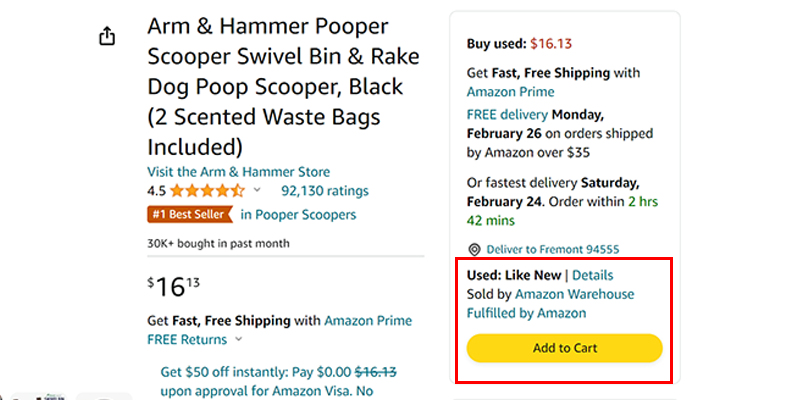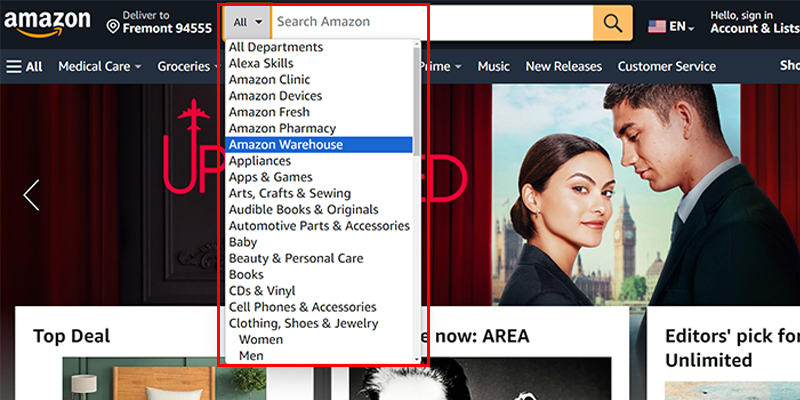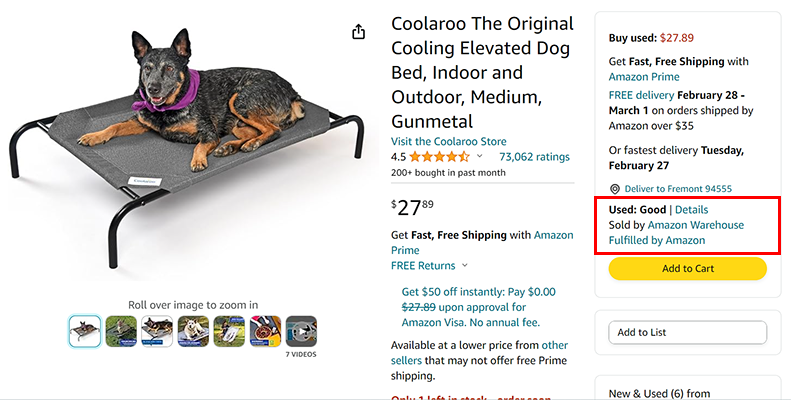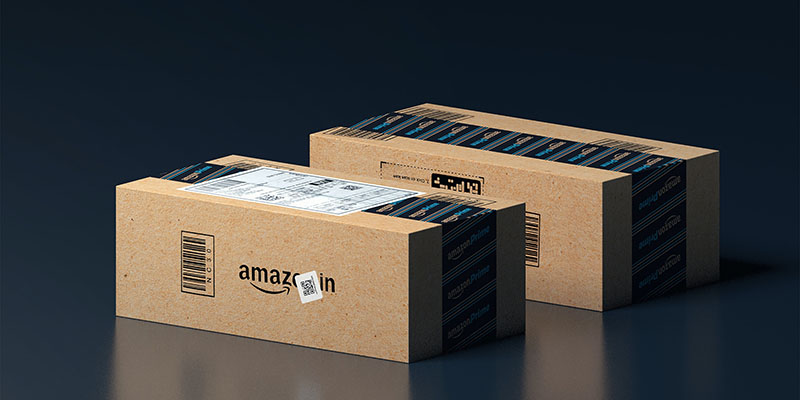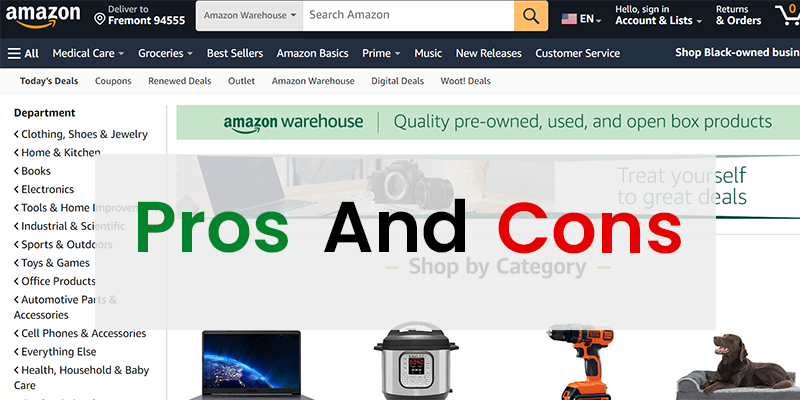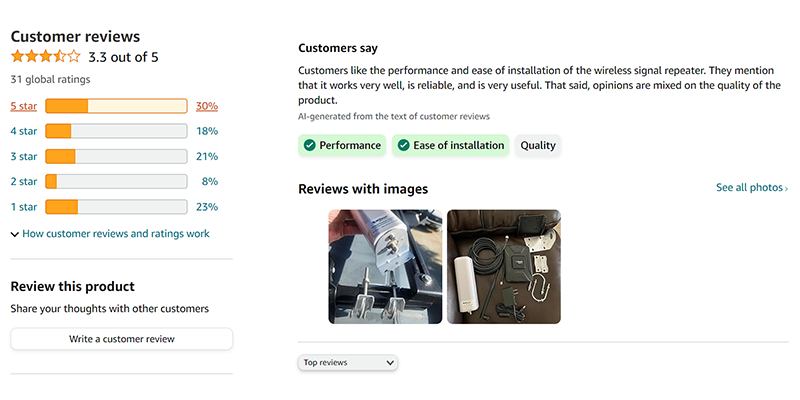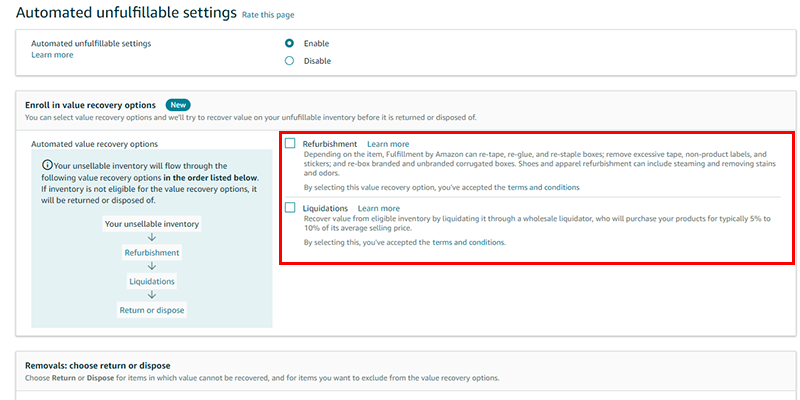Amazon Warehouse Deals is one of the top ways to buy like-new products at huge discounts. And the best part is that these products fall under Amazon’s 30-day return policy, so you can shop with confidence.
In this article, I’ll examine the pros and cons of buying from Amazon Warehouse, along with its impact on third-party sellers and their brands.
Whether you’re a buyer in search of great online bargains or a seller concerned about your listings, you’ll learn everything you need to know about Amazon Warehouse Deals.
Are you interested in creating a strong, defensible brand for your products? If so, I put together a comprehensive package of resources that will help you launch your own online store from complete scratch. Be sure to grab it before you leave!
What Are Amazon Warehouse Deals?
Amazon Warehouse Deals is an extended marketplace where Amazon.com offers discounted prices on warehouse-damaged, returned, open-box, and pre-owned products.
These products are usually those that customers have returned or have suffered packaging damage during transit but are still in good enough condition to be sold.
Before these items are listed on Amazon Warehouse, Amazon conducts a thorough inspection and testing of each product.
Each item comes with a detailed description, which allows you to make a well-informed decision about your purchase.
Amazon Warehouse Product Condition
The items under Amazon warehouse deals are categorized based on their condition: renewed, open-box, and used.
Renewed
An Amazon renewed item is a pre-owned, refurbished, or open-box product. Amazon or a qualified supplier inspects and tests these products to ensure they work and look like new.
When you look at a renewed item from a distance of 12 inches, you’ll notice minimal to no signs of wear, and there won’t be any visible cosmetic damage.
Renewed items may come repackaged and include all necessary accessories, though some might be generic 3rd party replacements.
Every renewed product is covered by the Amazon Renewed Guarantee. That means you can get a replacement or a refund within 90 days of purchase if it doesn’t meet your expectations.
For those interested in selling renewed products on Amazon, you can refer to my guide on Amazon Renewed for more information.
Used – Like New
“Like New” items are open-box items with limited usage that remain in good working condition.
They may have minor wear signs like small scratches or cosmetic blemishes. In addition, the packaging might be damaged, or the item may be repackaged.
Some accessories could also be missing, which will be clearly stated for each item.
Used –Very Good
Items classified as “Very Good” show wear but still function properly.
They might have marks, identifying markings, or cosmetic damage. The packaging could be damaged, or the item may be repackaged.
Some parts, accessories, instruction manuals, or assembly tools might be missing.
Used – Good
“Good” items show wear but are in good working condition.
They may have markings or cosmetic damage and could arrive in damaged packaging or be repackaged.
Expect some missing parts, accessories, instruction manuals, or assembly tools.
Used – Acceptable
Items in “Acceptable” condition are fairly worn but continue to work properly.
They exhibit significant cosmetic damage, including scratches, dents, and worn corners. The packaging may be damaged, or items may be repackaged.
Used-Acceptable items may also be missing multiple parts, accessories, instruction manuals, or assembly tools.
Where To Find Amazon Warehouse Deals
You can find Amazon Warehouse deals directly on Amazon.com or by visiting the Amazon Warehouse homepage.
Here’s how to find the best deals:
- Go to Amazon.com, click the drop-down menu, and select “Amazon Warehouse.”
- Search for “Amazon Warehouse” in the search box of Amazon.com
When you’re viewing a product, check the Buy Box on the right side of the page. It should list “Amazon Warehouse” as the seller.
For example, in the above image, you’ll notice the item is “Sold by Amazon Warehouse” and “Fulfilled by Amazon.”
You’ll also see that products sold on Amazon Warehouse are typically cheaper than those on Amazon.com, even during a sale.
What’s The Return Policy On Amazon Warehouse Deals?
Amazon Warehouse deals carry the standard Amazon return policy which allows you to return items within 30 days of receiving your order.
You also benefit from Amazon’s two-day shipping if you’re an Amazon Prime member.
Remember that each item in Amazon Warehouse is unique. If you return a product, Amazon can’t replace it with another in the exact same condition.
But they might have a similar item in stock, so it’s a good idea to look for alternatives if you need to make a return.
Are Amazon Warehouse Deals Safe?
Buying from Amazon Warehouse is 100% safe because most items, especially those in the ‘Used – Like New’ category are tested and guaranteed to work. In addition, every product carries a 30 day money back guarantee.
For example, a customer might return an unused black air fryer because they prefer a white one to match their kitchen.
In line with Amazon’s policies, this air fryer, despite being unused, will be resold as an “open box” item instead of being listed as new.
Similarly, if a customer purchases an iPad and later decides to return it for a model with more storage, the returned iPad is inspected by Amazon and then relisted at a discounted price.
However, be aware that some products in Amazon Warehouse might have minor scratches, dents, or other cosmetic issues.
These imperfections are typically the reason for the return and subsequent listing in Amazon Warehouse.
Pros And Cons Of Amazon Warehouse Deals
Amazon Warehouse Deals provides discounts on returned items in excellent condition, but they come with drawbacks like the lack of manufacturer warranty and potential difficulties in exchanging items.
Pros
- Discounted pricing: Amazon Warehouse Deals offers products at lower prices than their brand-new counterparts, providing a cost-effective option for shoppers.
- Great condition: Items are thoroughly inspected and are often in excellent condition. This ensures quality despite being returned or used.
- Return policy: These deals are covered by Amazon’s 30-day return policy. You get a safety net if the product doesn’t meet your expectations.
Cons
- No manufacturer warranty: Products bought through Amazon Warehouse Deals usually don’t include the original manufacturer’s warranty, which might be a concern for items that typically require post-purchase support.\
- Difficult to exchange: The exact item in the same condition may not be readily available due to the unique nature of each listing.
How Does Amazon Warehouse Work For Third-Party Sellers?
Third-party sellers cannot directly list items on Amazon Warehouse. However, Amazon may list items on their behalf in certain situations, such as when a product is damaged in an FBA warehouse or returned by a buyer.
If you’re a third-party seller using FBA and your product gets damaged in the FBA warehouse due to Amazon’s responsibility, Amazon inspects the item to determine if it can still be sold through Amazon Warehouse Deals.
If the item is deemed sellable, it gets listed in Amazon Warehouse, and you receive a refund for the damaged item.
But if a buyer returns the item and it is marked unsellable, you can choose to have Amazon dispose of it. Amazon may then inspect, refurbish, and resell the item through Amazon Warehouse.
How Do Amazon Warehouse Deals Affect Third-Party Sellers?
Amazon Warehouse Deals can create problems for third-party sellers because Amazon may resell their items as used without their direct control. This can potentially impact the brand reputation of the third-party seller.
If you’re a third-party seller with your own brand on Amazon, any negative reviews from Amazon Warehouse listings can affect your main Amazon listing.
This is due to Amazon’s review system, which associates reviews with the product listing as a whole, regardless of whether Amazon or a third-party seller is selling the item.
A common issue arises when Amazon incorrectly categorizes a returned product’s condition. For example, an item might be listed as “Used – Like New,” but the customer might not agree with this assessment.
In such cases, the third-party sellers have no control over the customer experience, as they are not the direct sellers of those items.
In addition, when Amazon reimburses third-party sellers for their returned items, the compensation is based on factors like average selling price and sales history. Amazon also deducts fees, which further reduces the payout received by the sellers.
So while Amazon Warehouse Deals offer buyers lower prices, they can pose significant issues for third-party sellers.
How Third-Party Sellers Can Prevent Amazon Warehouse Deals
While third-party sellers can’t completely stop Amazon from selling their products as used, they can reduce the likelihood of their products ending up in Amazon Warehouse by adjusting settings in Seller Central.
Here’s how to reduce the chances of your products being listed in Amazon Warehouse Deals.
- Go to “Settings,” then select “Fulfillment by Amazon.”
- Scroll to “Automated unfulfillable settings.”
- Uncheck the “Refurbishment” and “Liquidations” boxes under the “Enroll in value recovery options.”
When “Refurbishments” or “Liquidations” is enabled, your product will go through the following process:
- Amazon determines if your item is unsellable.
- Whenever Amazon deems that a product is not in a sellable condition, its status is changed to “Unfulfillable.”
- If “Refurbishments” is enabled, Amazon repairs unfulfillable items and relists them. Amazon charges you extra fees for the service.
- If “Liquidations” is selected, Amazon sells the item to a liquidator at 5% to 10% of its average selling price.
- For items that can’t be refurbished or liquidated, you have the option to have them returned to you or disposed of to save on storage fees.
- If you don’t create a removal order for unsellable inventory within 30 days of Amazon’s notification, items may be automatically disposed of.
Amazon sets refurbishments and liquidation options as default. So, make sure you disable these options manually if you don’t want your products to end up in Amazon Warehouse.
Is Amazon Warehouse Deals Worth It?
Amazon Warehouse Deals are 100% safe to buy and are a great option for buyers who want to purchase a like-new product with minor cosmetic issues at significant discounts.
For sellers, however, the picture is different. Allowing Amazon to refurbish and resell returned items might be convenient but often results in minimal financial return.
Typically, you receive only a small portion of the item’s original value.
In this scenario, the primary beneficiary is the buyer, which is consistent with Amazon’s focus on customer satisfaction.
As a seller, an alternative strategy is to have your unsellable goods returned to you for a fee. You can then list these items as used products on Amazon, which will give you more control over the resale process and potentially secure better returns.
Want to learn how? Check out my detailed guide one on How To Sell Used Items On Amazon for a step-by-step approach to selling your used items effectively on Amazon.
FAQs
What Is The Difference Between Amazon Warehouse Deals And Amazon Renewed?
Amazon Warehouse offers used or second-hand items with listings exclusively by Amazon, while Amazon Renewed provides refurbished products sold by both Amazon and third-party sellers.
Do Amazon Warehouse Items Have A Warranty?
Amazon Warehouse items do not come with a warranty, but they are covered by a 30-day return policy. In contrast, most products in the Amazon Renewed category are eligible for the Amazon Renewed Guarantee, which allows refund or replacement of products within 90 days of purchase.
Are Amazon Warehouse Deals Eligible For Prime Shipping?
Yes, Prime members can enjoy free shipping on all products listed under Amazon Warehouse Deals.

Ready To Get Serious About Starting An Online Business?
If you are really considering starting your own online business, then you have to check out my free mini course on How To Create A Niche Online Store In 5 Easy Steps.
In this 6 day mini course, I reveal the steps that my wife and I took to earn 100 thousand dollars in the span of just a year. Best of all, it's free and you'll receive weekly ecommerce tips and strategies!
Related Posts In Amazon Seller Tools
- Best 8 Amazon Scanner Apps For Retail Arbitrage
- How To 2X Amazon Sales By Using Viral Launch, Scope And Long Tail Pro To Target New Markets
- Amazon Warehouse Deals: How To Find Prices So Low, It Feels Like Stealing
- 5 Amazon Alerts That Will Change The Way You Manage Negative Feedback, Inventory And Sales
- Helium 10 Vs Jungle Scout – The Best Amazon Seller Tool

Steve Chou is a highly recognized influencer in the ecommerce space and has taught thousands of students how to effectively sell physical products online over at ProfitableOnlineStore.com.
His blog, MyWifeQuitHerJob.com, has been featured in Forbes, Inc, The New York Times, Entrepreneur and MSNBC.
He's also a contributing author for BigCommerce, Klaviyo, ManyChat, Printful, Privy, CXL, Ecommerce Fuel, GlockApps, Privy, Social Media Examiner, Web Designer Depot, Sumo and other leading business publications.
In addition, he runs a popular ecommerce podcast, My Wife Quit Her Job, which is a top 25 marketing show on all of Apple Podcasts.
To stay up to date with all of the latest ecommerce trends, Steve runs a 7 figure ecommerce store, BumblebeeLinens.com, with his wife and puts on an annual ecommerce conference called The Sellers Summit.
Steve carries both a bachelors and a masters degree in electrical engineering from Stanford University. Despite majoring in electrical engineering, he spent a good portion of his graduate education studying entrepreneurship and the mechanics of running small businesses.




